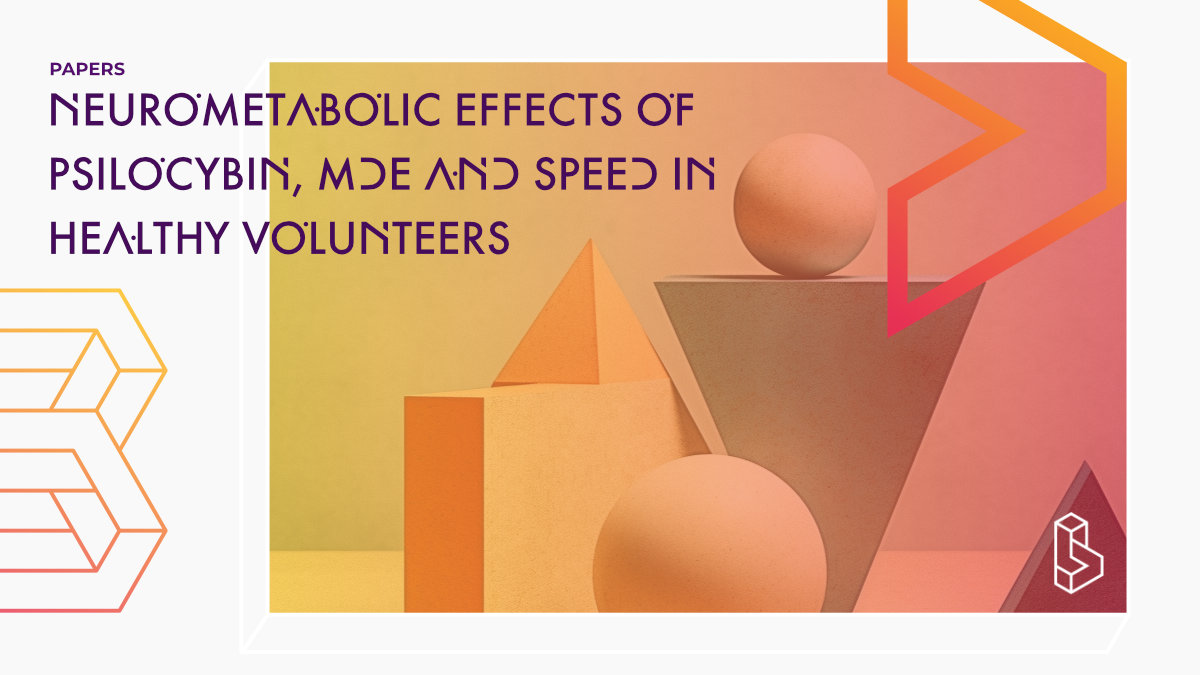This re-analysis of an RCT study (n=32) compared the neural correlates FDG-PET (n=8 per group) of MDE (140mg/70kg), psilocybin (14mg/70kg), and methamphetamine (14mg/70kg). The authors found that all three present unique neural profiles. Psilocybin increased regional metabolic rates of glucose (rMRGlu) in right frontotemporal cortical regions and decreased it in the thalamus, while MDE and METH-induced cortical hypometabolism and cerebellar hypermetabolism. Cognitive activation-related increases in left frontocortical regions were attenuated under all three substances but less under MDE, with different mechanisms potentially responsible for these effects across the groups.
Abstract of Neurometabolic effects of psilocybin, MDE and Speed in healthy volunteers
“The neurometabolic effects of the hallucinogen psilocybin (PSI; 0.2 mg/kg), the entactogen 3,4-methylenedioxyethylamphetamine (MDE; 2 mg/kg) and the stimulant d-methamphetamine (METH; 0.2–0.4 mg/kg) and the drugs’ interactions with a prefrontal activation task were investigated in a double-blind, placebo-controlled human [F-18]fluorodeoxyglucoseFDG-positron emission tomographicPET study (each group: n = 8). Subjects underwent two scans (control: word repetition; activation: word association) within 2–4 weeks. Psilocybin increased rMRGlu in distinct right hemispheric frontotemporal cortical regions, particularly in the anterior cingulate and decreased rMRGlu in the thalamus. Both MDE and METH induced cortical hypometabolism and cerebellar hypermetabolism. In the MDE group, cortical hypometabolism was more pronounced in frontal regions, with the exception of the right anterior cingulate, which tended to be hyperactive. Cognitive activation-related increases in left frontocortical regions were attenuated under all three psychoactive substances, but less so under MDE. Taking into account performance data and subjective reports on task difficulty, these effects may result from different mechanisms across the three groups. Our PSI data are in line with studies on acute schizophrenic patients suggesting frontal overactivity at rest, but diminished capacity to activate prefrontal regions upon cognitive demand. The MDE data support the hypothesis that entactogens constitute a distinct psychoactive substance class, which takes an intermediate position between stimulants and hallucinogens.”
Authors: Euphrosyne Gouzoulis-Mayfrank, Mathias Schreckenberger, Osama Sabri, Christoph Arning, Bernhard Thelen, Manfred Spitzer, Karl-Artur Kovar, Leopold Hermle, Udalrich Büll & Henning Sass
Summary of Neurometabolic effects of psilocybin, MDE and Speed in healthy volunteers
Experimental studies of cerebral blood flow and metabolism with psychoactive drugs in humans have shown that these drugs alter human brain function, especially in the anterior cingulate, which is linked to both emotional and attentional functions.
Hallucinogenic drug-induced states can be used as models for acute endogenous psychotic states in psychiatric research. Neuroimaging studies with acutely ill patients presenting with positive symptoms do not demonstrate hypofrontality, but do demonstrate hyperfrontal metabolic patterns.
Studies with hallucinogens and other psychotropic substances have shown decreased cortical activity, while studies with stimulant amphetamines have shown increases in glucose metabolism and cerebral blood flow.
Find this paper
Neurometabolic effects of psilocybin, (MDE) and d-methamphetamine in healthy volunteers
https://doi.org/10.1016/S0893-133X(98)00089-X
Open Access | Google Scholar | Backup | 🕊
Cite this paper (APA)
Gouzoulis-Mayfrank, E., Schreckenberger, M., Sabri, O., Arning, C., Thelen, B., Spitzer, M., ... & Sass, H. (1999). Neurometabolic effects of psilocybin, 3, 4-methylenedioxyethylamphetamine (MDE) and d-methamphetamine in healthy volunteers: a double-blind, placebo-controlled PET study with [18F] FDG. Neuropsychopharmacology, 20(6), 565-581.
Study details
Compounds studied
Psilocybin
Topics studied
Neuroscience
Healthy Subjects
Study characteristics
Original Re-analysis
Placebo-Controlled
Active Placebo
Randomized
Participants
24
Humans
Institutes
Institutes associated with this publication
RWTH Aachen UniversityRWTH Aachen University is a leading technical university located in the city of Aachen, Germany. It did some of the first psychedelic research of the third wave (1998).
Compound Details
The psychedelics given at which dose and how many times
Psilocybin 14 mgLinked Research Papers
Notable research papers that build on or are influenced by this paper
Psychopathological, neuroendocrine and autonomic effects of 3,4-methylenedioxyethylamphetamine (MDE), psilocybin and d-methamphetamine in healthy volunteers: results of an experimental double-blind placebo-controlled studyThis randomized, double-blind, placebo-controlled, between-subjects study (n=32) investigated the effects of MDE (140mg/70kg), psilocybin (14mg/70kg), and methamphetamine (14mg/70kg) on the mental state and the neuroendocrine and autonomic nervous system of healthy participants. The entactogen MDE took an intermediate position between the stimulant methamphetamine and the hallucinogen psilocybin and elicited highly characteristic emotional effects, that were qualitatively different from the effects of the other two drugs, which supports the hypothesis that entactogens constitute a distinct psychoactive substance class.

